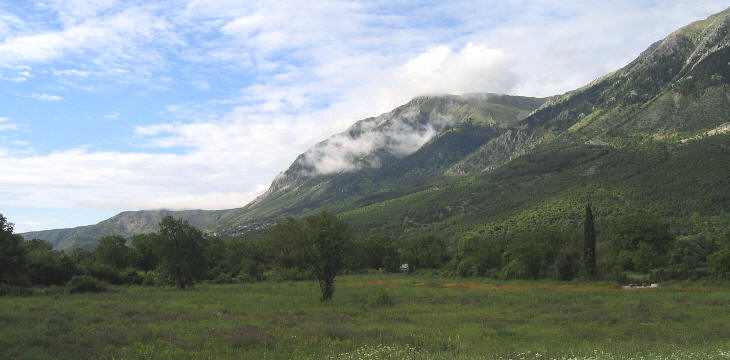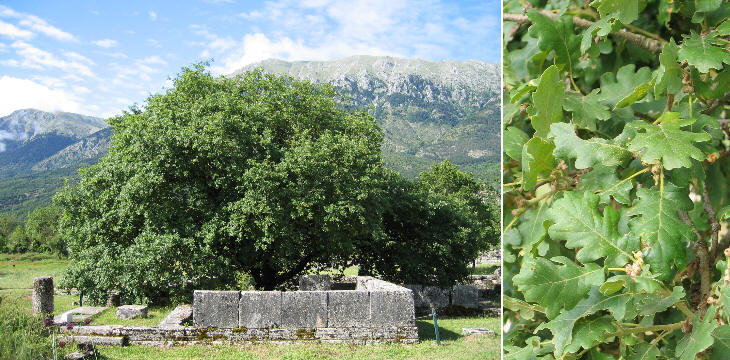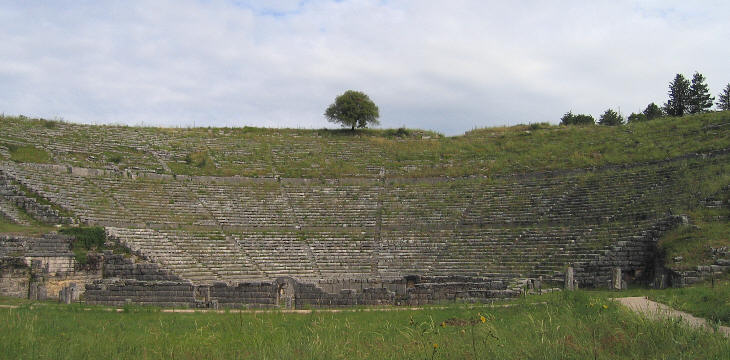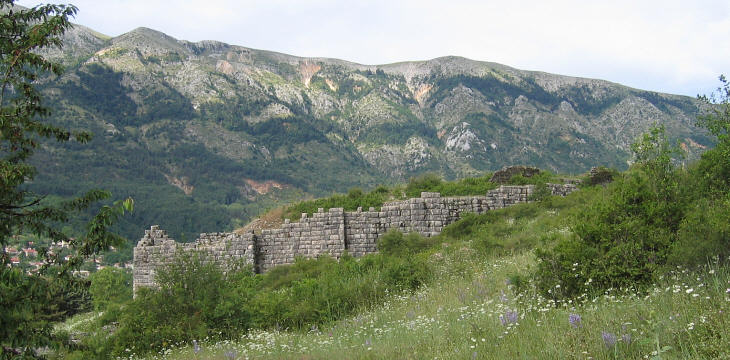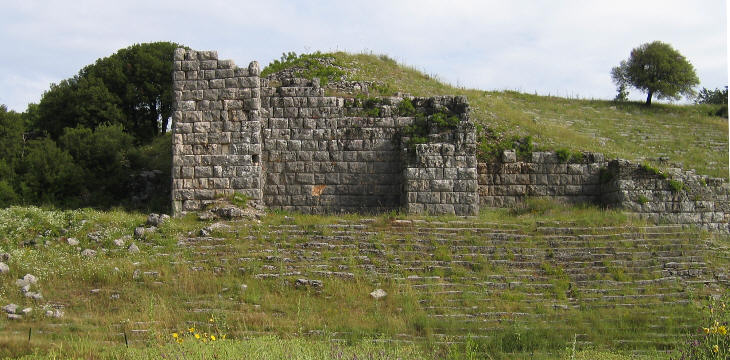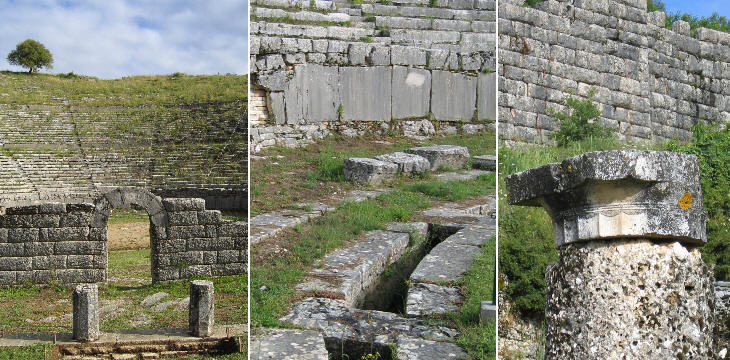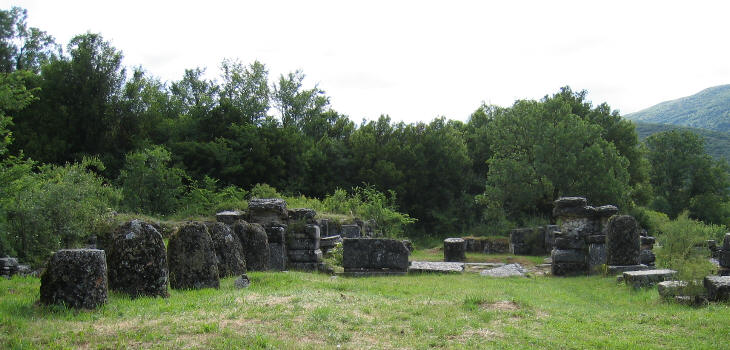  What's New! Detailed Sitemap All images © by Roberto Piperno, owner of the domain. Write to romapip@quipo.it. Text edited by Rosamie Moore. Page added in June 2007. |
 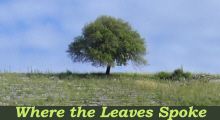 - The Shrine of Dodoni - The Shrine of Dodoni
Epirus is one of the regions into which the Republic of Greece is divided: it is located in the north-western part of the country: historical Epirus included part of southern Albania and other minor territories which now belong to other Greek regions. It borders on the Ionian Sea, but it has an almost alpine landscape: ridges of mountains which run parallel to the coast have always limited the access to and from Epirus. Its population amounted to around 350,000 in 2001 in a territory of 3,500 square miles, a very low ratio by European standards.
Even today forests and woods cover most of Epirus: in ancient times the few inhabitants who lived along the rivers and around the lakes were entirely surrounded by forests, which, although not comparable to a tropical jungle, nonetheless were not places to go jogging. Wild beasts typical of the alpine environment, such as bears and wolves, but probably also lions and other species of the cat family, lived in the forests.
Mountains and forests kept the most ancient inhabitants of Epirus in a state of isolation and their contacts with the Greek civilization which developed on the shores and the islands of the Aegean Sea were limited. Their religious beliefs were very much influenced by the environment which surrounded them: the major deity was a goddess-earth and she and the other deities were thought to live in the woods. According to Pliny the Elder (Historia naturalis: Book XII): Haec fuere numinum templa, priscoque ritu simplicia rura etiam nunc deo praecellentem arborem dicant; nec magis auro fulgentia atque ebore simulacra quam lucos et in iis silentia ipsa adoramus; arborum genera numinibus suis dicata perpetuo servantur, ut Iovi aesculus, Apollini laurus, Minervae olea, Veneri myrtus, Herculi populus; quin et Silvanos Faunosque et dearum genera silvis ac sua numina tamquam e caelo attributa credimus. "The trees formed the first temples of the gods, and even at the present day, the country people, preserving in all their simplicity their ancient rites, consecrate the finest among their trees to some divinity; indeed, we feel ourselves inspired to adoration, not less by the sacred groves and their very stillness, than by the statues of the gods, resplendent as they are with gold and ivory. Each kind of tree remains immutably consecrated to its own peculiar divinity, the beech to Jupiter, the laurel to Apollo, the olive to Minerva, the myrtle to Venus, and the poplar to Hercules: besides which, it is our belief that the Sylvans, the Fauns, and various kinds of goddess Nymphs, have the tutelage of the woods, and we look upon those deities as especially appointed to preside over them by the will of heaven" (translation by John Bostock and H.T. Riley). Trees and in general the vegetal world were also the location of afterlife; so Adonis was turned into an anemone, Daphne into a laurel and Narcissus into the flower by the same name.
When the inhabitants of Epirus had closer relationships with the Greek world, they adapted their beliefs to the patriarchal and more elaborated mythology of the latter. An oak which stood alone at the centre of a clearing and which was regarded as sacred, retained its holiness by becoming the residence of Zeus. This because "two black doves flew from Egyptian Thebes: one to Libyan Ammon, the other to Dodoni (the site of the sacred oak in Epirus). Each alighted on an oak-tree, which they proclaimed to be an oracle of Zeus. At Dodoni, Zeus' priestesses listened to the cooing of doves, or to the rustling of oak-leaves (and based on them their oracles)."(Robert Graves - The Greek Myths).
The Oracle of Dodoni was the eldest oracle, but not the most important: it was too far away from the centre of Greece; in a way we can call it a regional oracle. We should not look down on those who thought their fate was disclosed by what the leaves said; we should consider that not everybody believed in the oracle; the percentage of those who actually did so was probably not different from that of those who in our time read horoscopes, play solitaire or tarot cards as a way to know the likeliness of future events, or attach importance to superstitions as to what brings good or bad luck.
In the most ancient times there were no temples at the Oracle of Dodoni; when eventually a temple was dedicated to Zeus it was just a low wall marking a precinct around the sacred oak; the god was not in the cell of the temple but inside the roots of the tree, the cell being only a repository for the offerings made to the god; it is generally thought that columns were initially meant to represent trees; the first statues of the gods were carved from trunks as if to bring to light the god who was inside them.
The importance of the Oracle of Dodoni was revived by the Kings of Epirus: mainly by Pyrrhus (306-272) and by Philip V (221-179 BC). Pyrrhus raised the importance of a local festival, the Naia, with the objective of turning it into an alternative to the Olympic Games. This explains why a theatre and a stadium, both of a large dimension, were built at Dodoni which was not a town, but just the residence of the priests and their assistants.
The ambitions of the kings of Epirus came to an end when their expansion plans brought them in contact with Rome. Epirus was eventually conquered by the Romans in 168 BC and in 167 Dodoni suffered great damage. It was not however the end of the Oracle of Zeus which continued to be consulted: the theatre and the stadium were restored: during the rule of Emperor Augustus the theatre was modified so that combats with wild beasts and gladiatorial contests could take place; the stage was enlarged and a sewage system was dug to clean the stage after the fights; a wall was built in the lower tier to protect the spectators.
In 392 AD Emperor Theodosius declared the Christian faith the sole religion of the Roman Empire: to consult the Oracle of Zeus was forbidden; a church was built above some of the temples. Dodoni, deprived of its oracle and of the festival was abandoned after the raid of a barbarian tribe in the VIth century. Clickable Map of the Ionian and Aegean Seas with links to other locations covered in this website (opens in a separate window) SEE THESE OTHER EXHIBITIONS (for a full list see my detailed index). 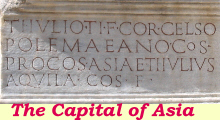 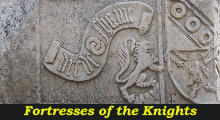 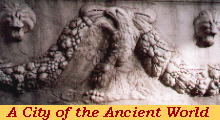
|
